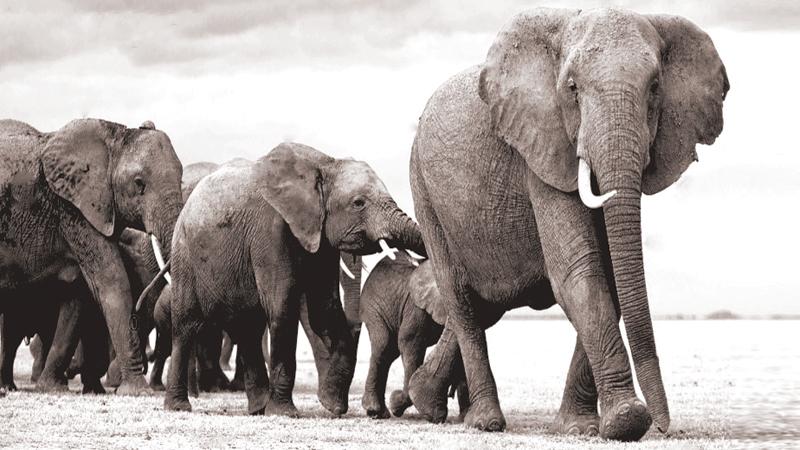
Elephants are well-known for their intelligence and social interactivity. They live in an environment with relationships ranging from the mother-offspring bond through families and beyond to strangers. These relationships between elephants may last for decades. But the quality and structure within the relationships may change over time.
Relationships
Elephants have distinct personalities that influence how they interact with other elephants, how others understand them, and how effectively they influence members of their group. For example, some elephants may be popular, show leadership qualities and are highly social while others are not.
Leadership
A matriarch is the oldest and largest adult female member of a family- to whom others orient and provide leadership in a moment of crisis. But there might be conflicts among families on who the matriarch is based on genetics, personality and history. They assert their power in both competitive and cooperative settings. Some are born leaders and display their abilities at an early age. The most successful leaders are confident, well-interacted individuals who are able to command the respect of others through their wisdom and charisma. In most instances, the matriarch’s suggestion is simply followed with less discussion and rarely has to argue her case.
Natural leadership qualities in socially demanding situations, maintaining close bonds within her family and lifelong experience are the makings of a wise matriarch.
Social organisation and families
 Elephants feed, rest, move and interact in a coordinated manner showing extraordinary teamwork, cooperation in group defense, resource acquisition, offspring care and decision making. Members of a family greet one another with a special “Greeting Ceremony.” Complex teamwork is mediated by a complex suite of vocalisations.
Elephants feed, rest, move and interact in a coordinated manner showing extraordinary teamwork, cooperation in group defense, resource acquisition, offspring care and decision making. Members of a family greet one another with a special “Greeting Ceremony.” Complex teamwork is mediated by a complex suite of vocalisations.
There are three types of elephant species, the African Savanna elephant, the African forest elephant, and the Asian elephant. African Savanna elephants typically live in large family groups. As a result, the number, variety, and complexity of their interactions and relationships may be greater than that of the two other elephant species. The individual elephants they meet will be related to them in varying degrees and known based on the frequency and quality of their previous meetings, and these factors will shape the nature and form of the relationship.
Elephant calls can travel long distances due to their powerful low-frequency vocalisations. From up to two kilometers away, elephants can recognise the voices of hundreds of other elephants. Family members, in particular, have a diverse vocal range and a remarkably extensive communication network mental capacity for extensive social recognition.
Elephants learn from others: The teamwork among elephants serves as a defense against predators as well as providing an environment where the young can mature and learn.Calves observe their mothers’ reactions to determine who are their relatives and friends and who are potential threats. They rely on their social companions to teach them appropriate responses to others. Calves learn to forage by sampling what the adults around them eat, and they practice mothering skills by associating with and mimicking the behavior of mothers of newborn calves.
Learning how and what to eat: Infants have little control over their trunks at first. They must practice trunk coordination and learn to apply it to obtain appropriate food from the environment. When calves are one to two months old, they begin to sample potential food. Picking up a potential food item with their trunk, rolling it in their trunk, placing it in their mouth, and chewing it is an example of sampling.
Elephant calves continue to suckle for about two years, during which time they gradually learn about foraging. They may also consume fresh dung from other elephants in order to obtain essential digestive bacteria and to increase food sampling through dung smell. Elephants have a variety of food sources, and calves learn about them through food sampling.
Learning mothering skills: Allomothering, or caring for the calves of other mothers, teaches young females important mothering skills. Contact with other calves and infants, as well as their mothers, provides them with a variety of mothering experiences that last until they give birth to their own first calf. Furthermore, the presence of allomothers improves a calf’s chances of survival.
Despite this practical experience, first-born infants experience more distress, stress, and death than infants born to older, more experienced mothers. When an inexperienced female gives birth for the first time, experienced females come to her aid and help her deal with the physical demands of birth through their behavior.
Vocal learning
Poole and colleagues added elephants to the small group of mammals (humans, some marine mammals, and bats) capable of vocal learning, or the ability to imitate sounds, in 2005. They reported a young female African elephant, Malaika, who had learned to imitate the sounds of distant trucks, and a captive male African elephant, Calimero, who had learned to imitate the chirping sounds of the Asian elephants with whom he had been raised. Their discovery uncovered additional reports of elephants who had learned to make unusual sounds (e.g., humming, purring, croaking, whistling).
Two reports, for example, described Asian elephants in a timber camp who had learned to make whistling sounds by blowing air through their trunks

